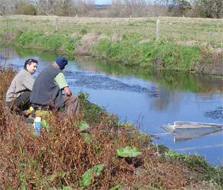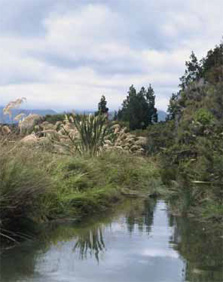Stream protection
Introduction
Learn about the benefits of streams on farms, how to provide for fish passage and how to protect fish habitat.No matter what your water source, without freshwater, you cannot farm the land. If you have water supplied by a stream, you have an obligation to safeguard the quality of the water leaving your property - for downstream users and for other stream life.
Streams and rivers provide habitat for plants, invertebrates, fish and wildlife. You may think there is not much life in your stream but take a spotlight and pay a night visit. Maybe use a scoop or net to get a closer look. You may be surprised at what you find, especially if the stream links to the sea.
Streams are worth protecting (PDF, 89K)
Streams on farms
In the past, streams were regarded as easy access to water for stock and the consequences of eroding stream banks and degraded water quality were largely ignored. Today most farmers realise that sustainable farming involves good environmental management. Allowing water to leave the property with an increased bacterial count, making it unsafe for drinking and swimming downstream, is not good farming practice.
More than that, managing waterways makes practical sense in terms of reducing soil loss from eroding banks, preventing stock from polluting waterways and improving the value of the stream for native wildlife, especially when the stream is fenced and planted.
Native freshwater fish

Banded kokopu
Thirty species of native freshwater fish (as well as 20 introduced species) reside or spend a significant part of their life cycle in New Zealand's rivers and streams. Fifteen species have a marine phase in their life cycle so access to and from the sea is crucial if they are to survive. Although your farm may seem a long way from the coast, the streams on your land could be a vital link to and from the sea for fish.
Native fish occur from sea level to elevations exceeding 1500 m but the greatest diversity can be found in low-elevation streams close to the sea. Banded kokupu and koaro prefer fast flowing, rocky bottom streams while inanga and giant kokopu live in swampy, lowland waterways. The young of all these species make up the whitebait catch.
These species rely on streamside cover to provide cool, sheltered habitat. Water temperature and clarity, dissolved oxygen, toxic substances and nutrients all have an effect on the feeding, spawning and health of fish.
Barriers to migration
Eels can swim 100 km or more inland and climb to over 1000 m. Along with kokopu and other whitebait, they navigate damp rocky faces up waterfalls or wet, sloping walls. However, many structures such as weirs, dams, fords and culverts impede access to upstream habitats. Likewise, adult eels can become trapped behind barriers, preventing their downstream migration. Fish can also be sucked into water intake structures unless they are suitably screened. Protecting access to habitats is as important as protecting the habitat itself.
Providing for fish passage
Including fish passages in waterway structures can help fish to maintain their natural migration patterns.
There are some general principles for existing culverts or installations of new culverts:
- Culvert slope and alignment should match the stream.
- Culverts need to be large enough to easily pass stream sediment and debris during floods especially through fords prone to blockage.
- The bottom of the culvert should be below the stream bed and it is essential that erosion does not result in a drop below the outlet creating a perched culvert.
- Where erosion is a problem, a weir could be installed to raise water levels below the outlet and provide resting pools, reduce current through the culvert by backwatering, and eliminate outlet drops.
- Protecting the banks against erosion with riprap (large rocks often contained within a metal cage) at the inlet and outlet of the culvert is essential.
Get information about fish passage management.
Protecting fish habitat

Protecting fish habitat is important for the future of conservation and recreational fishing
A number of things can be done to enhance the value of streams for fish - and in the process, safeguard water quality for other users.
- Fencing streams to restrict stock access.
- Providing cover and shade by maintaining overhanging plants alongside the stream.
- Planting trees, shrubs or flax along the northern, sunny side of the stream to shade the water. This keeps the water cool, slows down the growth of aquatic plants and in the process, acts as a filter for farm runoff for the betterment of water quality.
What to plant?
Most native plants take a long time to germinate from naturally dispersed seed through farm pasture. You can help the regeneration process by fencing and planting any retired grazing land.
Conditions on stream banks can vary from wet or boggy to shady or dry so you will need to choose plants most appropriate to the site.

Ideal fish habitat
- Wet stream banks: Cabbage tree, manuka, toetoe, mingimingi. karamu, flax, Carex secta, Carex virgata, kahikatea.
- Shady stream banks: Mahoe, mapou, wineberry, pate, ribbonwood, pigeonwood, pukatea, rimu, tree ferns. (Ground ferns should establish themselves naturally in damp places.)
- Dry stream banks: Kanuka, kowhai, Pittosporum species, totara
Select species that grow naturally together in your district. Avoid plants that are frost tender unless shelter is available.
If you have an open site that was grazed by stock prior to fencing, one option would be to densely plant kanuka on dry ground and manuka on wet or dry at 1.5 metre spacings to provide a quick cover. You can then underplant with other species over the next 2 to 4 years.
Further information
Further information that you might find useful:
- Local planting guides
- Managing waterways on farms
- Clean streams - a guide to managing waterways on Waikato farms
- Restoring Waikato's indigenous biodiversity
- Streamside planting guide
- Project Twin Streams
Contact your local Department of Conservation office.
Funding for stream protection
- DOC Community Fund – Pūtea Tautiaki Hapori provides funding to community-led conservation projects on public and private land.
- Regional councils may provide funding for stream restoration or riparian protection work
